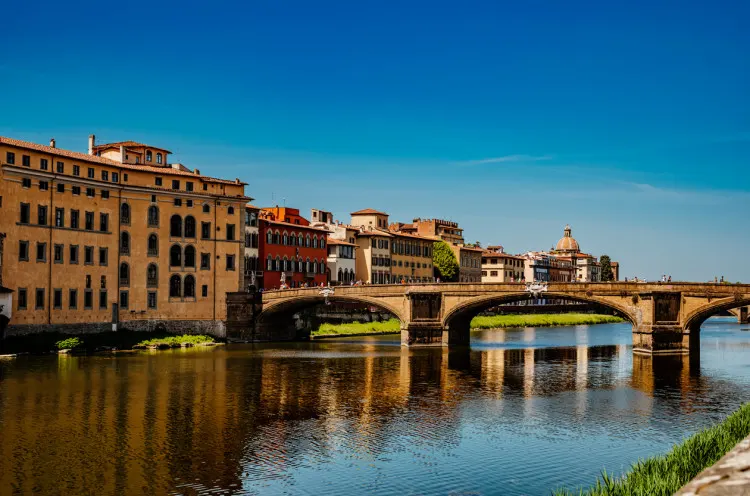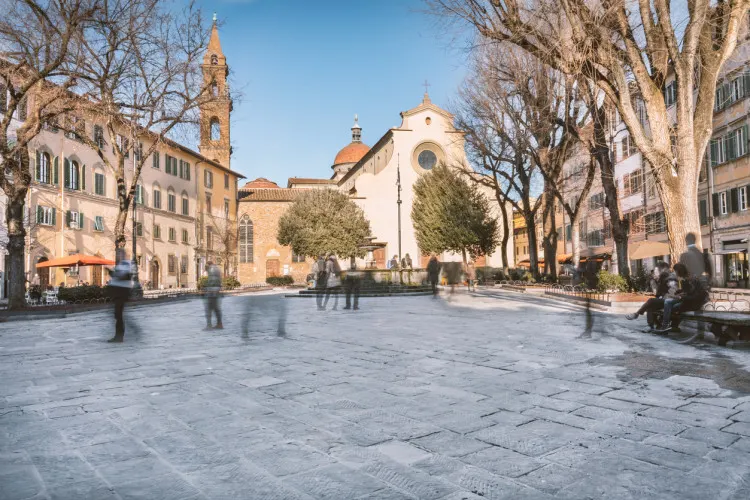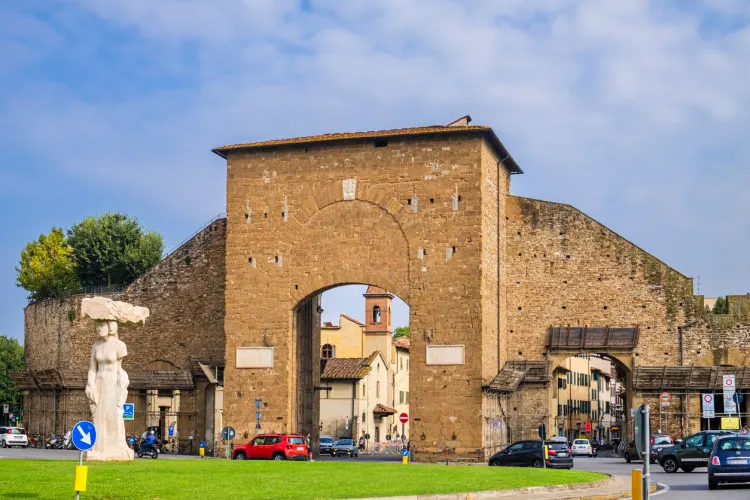Nine Hacks to Experience the Real Florence
9 min readModern-day tourism has a production-line intensity to it. Sense of place, cultural immersion…even relaxation, are all sacrificed in for an ever-longer list of highlights on the suggested itinerary. Never mind the quality, feel the width…
In Italy, Florence alone plays host to upwards of four million tourists a year. When you consider the concentration of visitors in the summer months, it’s reasonable to figure on 30,000 people turning up per day.
Even out of season, the main throughways from Florence’s Piazza Signorina to the Santa Croce basilica, or from Palazzo Pitti to the Baptistry of San Giovanni, are an exasperating torrent of robotic pilgrims, crocodile-walking in procession behind their designated guide for the day.
To be clear, I’m not saying you should avoid the big sights. Go see the Ponte Vecchio, the Galeria d’Accademia, the Uffizi, the Duomo, Santa Croce. Gird your loins, book your tickets at least six weeks in advance, and indulge yourself in the dripping opulence of a city that is in itself a creation of the highest art. Everything on that established tourist trail is worthy of your attention (along with the waiting in line and the inevitable irritation that comes of being elbow-to-elbow in a human mass).
But get it done, and get out of there. Then, head to the parts of Florence that are truly Florentine, and where an hour simply sitting at a terrace café table will provide you with sights, sounds, and atmosphere that will linger longer in your memory than any marble statue, crenelated palace, or oversized portrait.

Ponte Santa Trinita.|©iStock/lucentius
Sunset is the best free show in Florence. Head to the Ponte Santa Trinita as the shadows begin to lengthen. With wide, flat walls, it’s comfortable for sitting (unoccupied seating in the city is extremely difficult to find, so take it where it comes) and it offers the best view in Florence of the Ponte Vecchio and river Arno reflecting the russet light of evening.
While you can’t control when the sun sets, if you time your trip outside of the high season of June, July, August, and Easter Week, you’ll already go a long way toward having an insider experience.
Additionally, the Ponte Santa Trinita is the gateway to the Oltrarno district of Florence. Variously described as “Bohemian” and “artsy”, it’s more accurate to say that Oltrarno is simply the closest genuinely residential section of the city to the central quarter’s galleries, hotels, churches, museums, and retail outlets.
The moment you arrive on the south bank of the Arno, it feels as if the pressure has lifted, though it may take a little more distance to shuck off the hordes. Ignore Gelateria Santa Trinita and instead walk a block west along the river to Gelateria La Carraia. The lines of people waiting to enter might suggest a tourist trap, but if you listen closely, you’ll notice as many speaking Italian as there are foreigners. That’s a good sign, and you’ll get as good a scoop of gelato here as you’ll find anywhere in Florence.
From there, it’s a mere block southeast to Babae Wine Window, on Via Santo Spirito. Get there between 7 p.m. and 8 p.m. for a chance to indulge in a slightly contrived, but still enjoyable, Florentine tradition. Some 120 wine windows exist in the city, but Babae’s is one of only seven or so that still function.
Back in the 1600s, the city fathers decreed that landowning families with townhouses in Florence could be permitted to sell wine from their estates directly from their city properties. The families proceeded to do so with gusto, via eye-level portholes not much bigger than a bottle of wine cut into the thick defensive walls of their palatial homes. (You can’t be too careful, after all.)
A fun way to get an alternative perspective on Florence is to keep an eye out for decommissioned wine windows as you stroll through the Oltrarno district. Many have been bricked up, some have been converted to mailboxes, but they’re unmistakable once you learn to recognize them.
At Babae, you can buy a selection of drinks from a wine window. It’s a bit of a gimmick, really, since the window is connected to the interior of the restaurant of the same name, but it’s still a fun way to connect with the generations of Florentines who tippled here over the centuries.
An interesting detail is that as well as red, white, and rosé, Babae also serve orange wine—an increasingly fashionable trend in the wine world where wine made from white grapes is left in contact with the grape skin for long enough for a controlled oxidation to take place, and the characteristic color to occur. You can drink your wine on the street outside the window, before heading a block southeast to the Piazza Santo Spirito.

Piazza Santo Spirito. |©iStock/TommasoT
Piazza Santo Spirito is a workhorse plaza that is partly produce market, partly unofficial children’s playground, partly al fresco dining area, and wholly typical Italian public space. The basilica bells toll the hour in joyful arpeggios, starlings flit between the beech trees, and kids chase each other over the herringbone flagstones of the central square.
Café Ricchi, on the eastern flank, is as good a bet as any. Grab a scalding espresso at the bar for €1.20 (it always costs less to drink while standing by the bar) or pay a little extra to sit at an outdoor table. Either way, you’ll feel that you’ve carved a little piece of Florence as your own.
Oltrarno is the gateway to one of Florence’s most interesting sections. In truth, there are purely residential, modern areas of Florence in every direction outside of the center. Most are pleasant and livable, but have nothing in particular to recommend them to the visitor.
The exceptions are the Oltrarno, Sant’ Ambrogio, and Porta Romana districts. These traditional areas of the city are central, and historical, but still hidden from the tight-focus gaze of mass tourism. In purely practical terms, they’re also great places to find authentic eateries.
The challenge is in keeping ahead of the websites, vlogs, TikTok channels and Instagram influencers. When you come across a long line of people waiting to eat at a restaurant where the chef comes outside to theatrically mix tagliatelle with cream sauce at the tableside, you can bet that the joint’s popularity owes more to its instagrammable performance than to the quality of its food. It happens more often than you’d hope.
Learn more about Italy and other countries in our daily postcard e-letter. Simply enter your email address below and we’ll send you a FREE report – Italy: Europe’s Most Seductive Country.
By submitting your email address, you will receive a free subscription to IL Postcards and special offers from International Living and our affiliates. You can unsubscribe at any time, and we encourage you to read more about our Privacy Policy.
One trick is to search for restaurant recommendations in Italian. “Dove mangiare bene a Firenze” is a good starting point. You can Google Translate the results. It’s not foolproof by any means—I couldn’t get a table at the now-discovered Il Brindellone on Piazza Piattellina, for example—but it can lead you in the direction of lesser-known districts with good local restaurants.
One such district is the area around the Porta Romana at the southeast corner of the Boboli Gardens. Alla Vecchia Bettola on Viale Vasco Pratolini is the pick of the bunch for traditional Florentine cuisine, but it gets jammed with locals very quickly.
If you can’t get a table, their sister restaurant across the street, Alla Bettolina, serves an abbreviated version of the same menu in a more informal setting. House wine, for example, is served in an oversized Chianti bottle complete with basket base, with your wine bill calculated by the level of the bottle after you’ve finished.
It’s not exceptionally affordable—nowhere in Florence is—but you can expect two courses with wine to come in at less than €30. The menu changes with the seasons, but it’s always authentic Tuscan cuisine, and it’s a good spot to indulge in the celebrated Florentine beef steak without paying the eye-watering prices of more central Florence.

Porta Romana.|©iStock/Orietta Gaspari
The Porta Romana is, as its name suggests, the site of Florence’s ancient Roman gate and walls. That part of the city’s history gets overlooked for the flashier Renaissance quarter, but the gate is worth seeing. It’s also the starting point for a rewarding, if challenging, walk up the grand boulevard of Viale Machiavelli, twisting past the delightful formal Giardano del Bobolino (not to be confused with the larger Giardano del Boboli) and up into the cypress trees and olive groves of Florence’s steep southern valley side.
If you follow the highway upwards to Viale Galileo, another 20 minutes’ walk is well rewarded with sumptuous views of the city, still dominated by the candy-striped Duomo at its highest, and the Arno valley. What’s more, from the viewpoint on Viale Galileo, it’s downhill to the throbbing melee of souvenir stalls, puzzled tourists, and pounding music that is the Piazzale Michelangelo.
To be fair, the Piazzale Michelangelo has wonderful city views, and at its centerpiece is a bronze casting of David that Michelangelo himself had a hand in producing (the plastercast version in Piazza Signorina is a 19th-century copy of the original marble sculpture that you can see in the Galeria Del Accademia).
For my money, the bronze version here in the open air, free to view, is actually more impressive than the marble original. The weathering of centuries makes it, somehow, more imposing. The tour bus crowds grabbing selfies with it are less appealing.
Directly downhill to the west, though, is an often-overlooked gem. The terraced rose garden, with a very inviting outdoor bar serving cold beers and Aperol Spritzes at a reasonable price (€5 to €7), is a welcome antidote to the crush of Piazzale Michelangelo and its overpriced terraces throbbing with cheesy 1980s pop at nosebleed volume.
Another recommended district is Sant’ Ambrogio. Directly north of the exquisite-but-overcrowded Basilica de Santa Croce, the Piazza Sant’ Ambrogio is an oasis of sanity after the doddering tour groups and pushy restaurant touts around that admittedly impressive Romanesque beauty.
Despite evident attempts at gentrification, the Sant’ Ambrogio quarter is a defiantly local district of traditional butchers, bakers, and even a food stall specializing in the definitive Florentine delicacy—lampredotto. (The fact that the stall does a brisk trade is testament to how authentic the area is. True Florentines are surely the only ones who can get so enthusiastic about a sandwich filled with the boiled linings of a cow’s fourth stomach.)
Don’t be put off by the offal, though. A culinary highlight of a trip to Florence is to eat at Trattoria da Rocco, inside the decidedly workaday Sant’ Ambrogio produce market. Within its cast-iron and terracotta confines (on Sundays, an antique/flea market takes place around the building’s exterior), Rocco and his extended family dish up hearty Tuscan dishes to a clientele who range from market workers grabbing a bite to well-heeled gastronomes on culinary pilgrimage.
Seating is at shared tables on polished wooden benches, and if there’s room, they’ll fit you in. I shared a booth with three Italian women celebrating a retirement, and our efforts to converse in any and every language we could muster was a highlight of my time in Florence.
As for the food, think in terms of classics such as ribollata (bean soup), peposo (slow-cooked beef in black pepper sauce), and perfectly executed pasta dishes. House wine is a quaffable Chianti, the panna cotta is delectable, and the menu comes with an English translation that makes it easier to avoid unexpected tripe dishes (always a risk in Florence).
Learn more about Italy and other countries in our daily postcard e-letter. Simply enter your email address below and we’ll send you a FREE report – Italy: Europe’s Most Seductive Country.
By submitting your email address, you will receive a free subscription to IL Postcards and special offers from International Living and our affiliates. You can unsubscribe at any time, and we encourage you to read more about our Privacy Policy.



